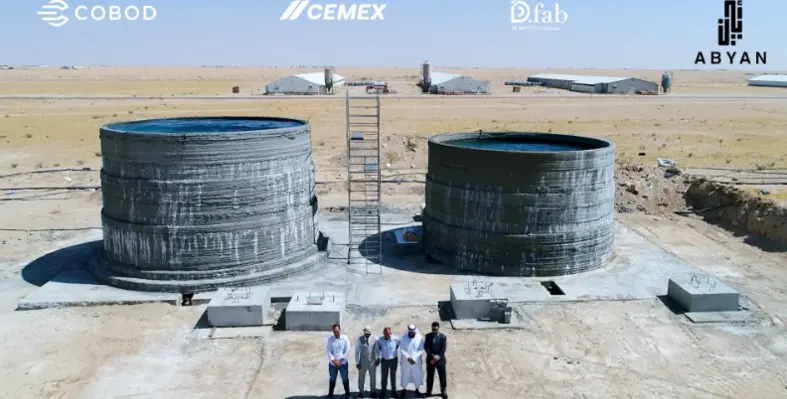In Kuwait, Abyan, alongside CEMEX and COBOD, is reshaping tank construction through innovative 3D printing methods, pioneering sustainability and efficiency in collaboration with Kuwait United Poultry Company
In traditional tank construction using formwork and concrete, the uniform thickness of tank walls is dictated by the limitations of formwork. 3D construction printing eliminates this constraint, empowering structural engineers to vary wall thickness strategically. In cases like constructing large tanks, where gravity and water pressure induce varying stress levels, 3D printing allows for thicker walls at the bottom, where stress is higher, and thinner walls at the top. This not only optimises material usage but also enhances the economic and sustainable aspects of tank construction.
The practical application of this engineering principle is evident in a tank in Kuwait, showcasing a variable wall thickness of 40cm at the bottom, 30cm in the middle, and 20cm at the top. This innovative approach resulted in a 25% reduction in concrete and reinforcement compared to a conventional tank with uniform 40cm walls.
These tanks were printed using a cost-effective C40/50 concrete mix produced on-site through the D.fab solution and associated printing equipment developed by CEMEX and COBOD. Notably, 99% of the raw materials were locally sourced, aligning with sustainability goals. To further expedite construction, Abyan, the project initiator, incorporated macro fibers for concrete reinforcement. This unconventional use of macro fibers posed a challenge, as it had not been previously employed in the reinforcement of 3D printed real-life structural constructions.
Henrik Lund-Nielsen, founder and general manager of COBOD said, “Abyan pursues real innovations, which we really want to support and they wanted to try to avoid using any hard reinforcement in the walls, and just add fibers to the concrete. Of course, this challenged us a lot, but together with Cemex, the three of us were able to find a very good solution, which now can be replicated elsewhere in the future”.
Abyan’s willingness to be innovative and try out new solutions is a consequence of the scientific background of the CEO and co-founder of Abyan, Dr Ahmad Al-Nassem, who is a professor of structural engineering at Kuwait University.
Dr Ahmad Al-Nassem said, “It is in the DNA of Abyan to be innovative. Abyan is wholeheartedly committed to revolutionising the construction industry at large by integrating cutting-edge 3D printing technology within concrete construction along with innovative solutions in design and construction materials, bringing forth a new era of efficiency and sustainability. So, when all of our calculations showed that with 0,95% macro fibers in the concrete, we could remove all hard reinforcement of the tank walls, we were keen to prove this new design concept with a real-life project”.
The two tanks were printed for Kuwait United Poultry Company and will be used for chicken drinking water at one of their many chicken farms in Kuwait. Due to the cost and time savings realised in the project, Kuwait United Poultry Company is keen to continue 3D constructing printing for tanks in the future.





